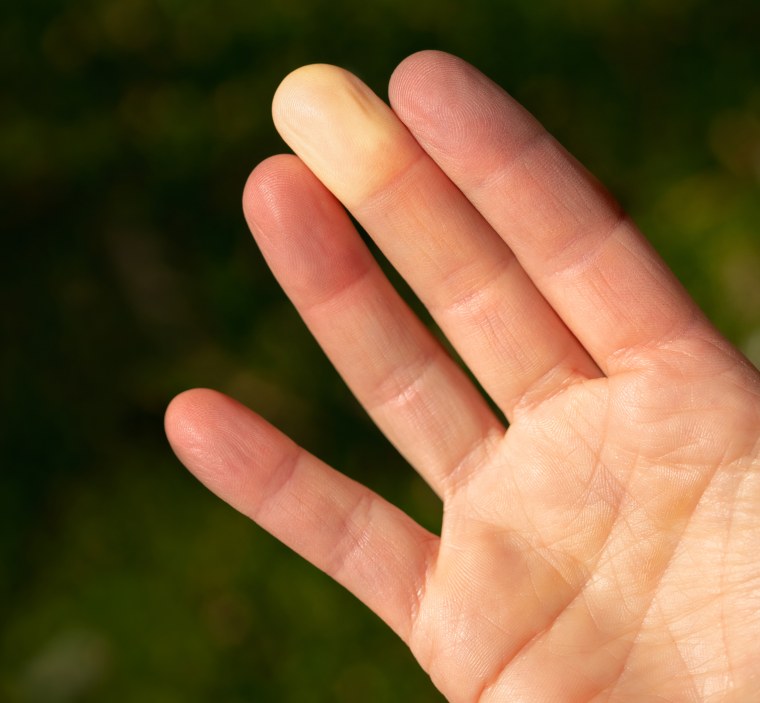Raynaud’s phenomenon, which causes parts of the body like the fingers and the toes to go cold and numb, likely stems from two genes, a study published Thursday in the journal Nature Communications found.
The results of the study — the largest genetic study of the condition to date — could lead to more effective treatments, experts said.
In people with Raynaud’s phenomenon, cold temperatures or stress trigger spasms in the small blood vessels near the surface of the skin, causing the vessels to constrict and limit blood flow. The fingers and toes are most commonly affected, according to the Mayo Clinic. The skin will turn white or blue and then red when the attack ebbs.

“It gets painful and numb,” said Dr. Marie Gerhard-Herman, an associate professor at Harvard Medical School and a staff physician at Brigham and Women’s Hospital specializing in cardiovascular medicine. During an attack, people may not be able to move their hands as they want, added Gerhard-Herman, who was not involved with the new study.
Dr. Laura Hummers, a rheumatologist and an associate professor at Johns Hopkins Medicine, said that while medications for Raynaud’s are available, they can have unwanted side effects.
“The main therapy currently is a class of drugs called calcium channel blockers,” said Hummers, who was also not involved with the new research. “Those therapies are fairly helpful.” But they lower blood pressure, which can be a problem for otherwise healthy people, she said. And they can cause side effects, such as constipation, dizziness and headache, according to the Cleveland Clinic.
Raynaud’s occurs in 2% to 5% of the population, more commonly in women, and takes two forms.
Primary Raynaud’s is by far the most common and is typically diagnosed in teenage girls and women in their 20s, Gerhard-Herman said. Its symptoms are often manageable with lifestyle changes alone, such as avoiding cold and limiting stress. However, some patients’ symptoms are so bothersome that they must use medication.
The genes identified in the study are linked to primary Raynaud’s.
Secondary Raynaud’s is rare and its symptoms can be more serious, including ulcers on fingers and gangrene, and medication is often necessary. It occurs in people with autoimmune diseases such as scleroderma, which causes thickening and inflammation of the skin, and lupus, which causes inflammation throughout the body.
Raynaud’s runs in families and is heritable. “About half the people who have primary Raynaud’s phenomenon have another first-degree relative who also has Raynaud’s,” said Hummers, who co-directs John Hopkins Scleroderma Center.
The new study explains why.
Researchers in London and Berlin looked at data from more than 440,000 people in the UK Biobank, a massive database containing genetic and medical information.The team identified 5,147 cases of Raynaud’s, 68% of which were primary Raynaud’s. Another 439,294 records served as controls.
“We identify two distinct genes that point to two distinct mechanisms,” said Maik Pietzner, one of the study’s lead researchers and chair in health data modeling at Queen Mary University of London’s Precision Healthcare University Research Institute.
One gene variant affects how blood vessels narrow. People with this variant have a high number of a particular receptor for hormones that are released when the body is stressed or cold, he said. These hormones signal the tiny blood vessels in the skin to constrict, allowing blood to flow away from the extremities and to the body’s vital organs. The other gene variant affects how blood vessels dilate, or relax, he said.
The findings could hopefully lead to new treatments: Drugs could be developed that target this hormone receptor, for example, Pietzner said. One existing drug, an antidepressant called mirtazapine, already acts on the receptor and could possibly be repurposed for people with Raynaud’s, he said.
“For patients, it’s all about finding treatments,” he said.
While the two gene variants were linked to primary Raynaud’s, not to the secondary form, any new drugs developed might help people with both, Hummers said.
The researchers noted that the study had limitations. For example, they relied on diagnostic codes in people’s electronic health records, which aren’t always reliable. As a result, some cases of Raynaud’s may have been missed while others might have been misdiagnosed.
In addition, the participants were all of European descent, and so the results cannot be generalized to all people. More studies are needed, the researchers wrote.
“They need to actually look at people with other ancestries,” Gerhard-Herman said.
Still, the large study is the first to identify the underlying genetics of the condition. “The genetic studies that have been done in Raynaud’s up until this point hadn’t been as compelling as this one,” Hummers said.
“It’s a huge step forward,” she said.
Follow NBC HEALTH on Twitter & Facebook.






